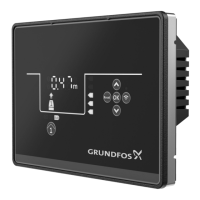6.11 "Antiseizing"
The Antiseizing function prevents a pump from choking or seizing up as a result of deposits buildup. Antiseizing is used in pits that have had
no inlet flow for a long period. The Antiseizing function ensures that the pump starts as often as set in Antiseizing > interval. The pump will
operate for the number of seconds indicated by the user.
6.11.1 Setting the "Anti-seizing" function with Grundfos GO Remote
1. Go to Settings > Anti-seizing.
2. Set the function to Enabled.
3. Set the time interval.
4. Set the operating time.
6.12 Signal-detection time
The signal-detection time is the minimum time a level has to be active before the control unit initiates an action, such as starting or stopping a
pump.
6.12.1 Setting the signal-detection time with Grundfos GO Remote
1. Go to Settings > Level control > Signal detection time.
2. Set the signal-detection time.
6.13 Setting the maximum number of restarts with Grundfos GO Remote
If the pump is seized up as a result of deposits buildup, it will be stopped automatically due to overheating, provided that the motor protection
has been set. When the motor has cooled down, the control unit will unsuccessfully try to restart the pump and this scenario will be repeated.
In order to prevent this, it is possible to set a maximum number of restart attempts within a set interval.
1. Go to Settings > Max number of restarts.
2. Enable the function.
3. Set the interval within which the allowed number of restarts are to be counted.
4. Set the maximum number of pump restarts which are allowed during the set interval.
Related information
6.15.4 Setting the motor protection with Grundfos GO Remote
9.3 Code 4 (Too many motor restarts)
6.14 Setting the service interval with Grundfos GO Remote
You can set a time in Grundfos GO Remote in order to get a reminder that the pump needs service when the time comes.
1. Go to Settings > Service > State
2. Select Enable and press OK.
3. Select the pump.
4. Enter the number of hours until next service and press OK.
6.15 Motor protection
6.15.1 Overheat protection
The control unit offers thermal protection for the connected motors. Two types of thermal-protection sensor can be connected to the control
unit: a PTC sensor (analog) and a thermal switch (digital).
Under normal running conditions, the sensor will act as a short circuit, but when its temperature limit is reached, it will open and tell the control
unit that the temperature is too high, and the pump is stopped. When the temperature has dropped to the sensor-trigger level, the pump will
return to normal running conditions. It will not be possible to start the pump manually as long as the temperature is too high.
Related information
9.10 Code 69 (Winding temperature too high)
6.15.2 Overload protection
The pump is protected by a motor-protection relay. The nominal current draw must be set manually on the motor-protection relay. See the
specific documentation for the relay on how to set the trigger level. If the current exceeds the trigger level, the relay will switch off the pump
and the controller will give an alarm. The alarm has to be manually reset directly on the motor protection relay.
Related information
9.8 Code 48 (Motor is overloaded)
6.15.3 Moisture protection
When a moisture sensor is installed in series with the temperature sensor, the control unit needs to know how to determine whether there is a
high temperature or moisture in the pump. If the temperature is too high, normally the temperature sensor will go back to its normal stage
when the temperature has dropped to its trigger level. If there is moisture in the pump, then the moisture sensor will keep the series
connection open until the pump is opened and serviced.
To determine which sensor has been active, a cool down time must be entered. This is the time that will normally pass until the temperature
has dropped enough for the temperature sensor to return to its normal stage. If the cool down time is exceeded, the control unit will assume
that there is moisture in the pump, and it will send a moisture alarm.
19
English (GB)

